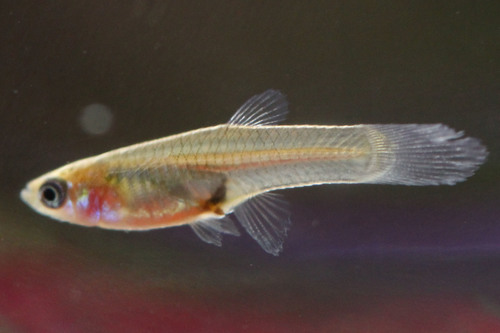
Guppy
The Atlantic Bluefin Tuna (Thunnus thynnus) is a majestic and powerful fish, renowned for its size, speed, and commercial value. This highly migratory species plays a crucial role in the marine ecosystem and has been a prized catch for centuries. However, its popularity has led to significant population declines.
1 2 years
Lifespan
3 - 6 cm
Length
Least Concern
Conservation Status
8 km/h
Swimming speed
Omnivorous, Detritivorous
Diet
Local Migration
Migration
Appearance Overview
The Atlantic Bluefin Tuna is renowned for its large, streamlined body, built for speed and endurance.
Color
Dark metallic blue above, silvery white below
Body Shape
Torpedo-shaped, fusiform
Fins
Two dorsal fins, the first depressible; small finlets running from dorsal and anal fins to tail
Keel
Strong keel on the caudal peduncle (base of the tail)
Length
Up to 13 feet (4 meters), commonly 6.5 feet (2 meters)
Weight
Up to 2,000 lbs (907 kg), commonly around 550 lbs (250 kg)
Diet
Carnivorous, feeding on a variety of fish (such as herring, mackerel, and hake), squid, crustaceans, and eels.
Feeding Behavior
Opportunistic and highly active predator, often hunting cooperatively. They can dive to considerable depths to pursue prey.
Social Behavior
Forms large schools, especially when young. Schools may be segregated by size. Highly migratory, capable of crossing entire oceans.
Commercial Relevance
Extremely high value, particularly in the Japanese sushi and sashimi market, where a single fish can fetch hundreds of thousands of dollars.
Conservation measures
Subject to international fishing quotas and management plans (e.g., ICCAT). Some marine protected areas offer limited refuge.
Status
Endangered (IUCN)
Threats
Overfishing (historically and continuing), bycatch in other fisheries, climate change affecting prey distribution, habitat degradation.
Habitat Distribution
Depth Range
0-1,000 meters (0-3,280 feet), most commonly in the upper 200 meters (656 feet)
Geographic Range
Atlantic Ocean, Mediterranean Sea, and formerly the Black Sea. Includes both western and eastern Atlantic populations.
Preferred Environment
Temperate and subtropical waters; pelagic (open ocean), often near continental shelves and slopes.
Reproduction and Life Cycle
Breeding Habits
Spawns in warm waters, primarily in the Mediterranean Sea and the Gulf of Mexico. Spawning occurs in large aggregations.
Development Stages
Eggs are pelagic (free-floating). Larvae develop rapidly, feeding on plankton. Juveniles grow quickly, forming large schools.
Fecundity
Highly fecund; a large female can release up to 30 million eggs per spawning season.
Maturity Age
Matures at around 4-8 years in the western Atlantic and 3-5 years in the eastern Atlantic/Mediterranean.
Faqs about Guppy
How long do Atlantic Bluefin Tuna live?
They can live up to 40 years, although many do not reach this age due to fishing pressure.
How fast can Atlantic Bluefin Tuna swim?
Atlantic Bluefin Tuna are among the fastest fish in the ocean, capable of bursts of speed up to 43 mph (70 km/h).
Are Bluefin Tuna warm-blooded?
Yes, they are warm-blooded, unlike most fish. They maintain a body temperature higher than the surrounding water, allowing for greater muscle efficiency.
What organization manages Bluefin Tuna fishing?
ICCAT (International Commission for the Conservation of Atlantic Tunas) is the primary organization responsible for managing Bluefin Tuna stocks.
How are Bluefin Tuna caught?
They are primarily caught using purse seines, longlines, and harpoons. Historically, traps (called 'tonnara' in the Mediterranean) were also used.
What is special about bluefin tuna?
Bluefin tuna have a unique ability to maintain a higher body temperature than the surrounding water, which is an adaptation for their highly migratory and predatory lifestyle.
Copyright @ Nature Style Limited. All Rights Reserved.
 English
English